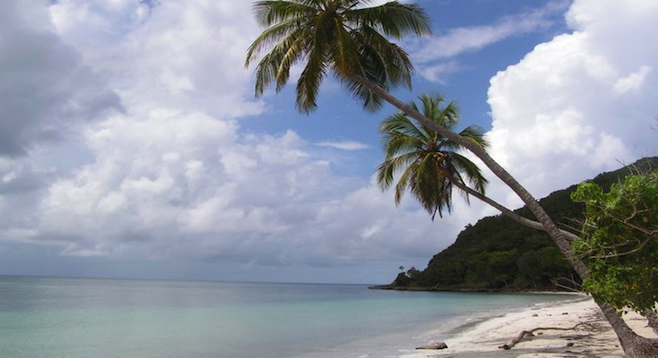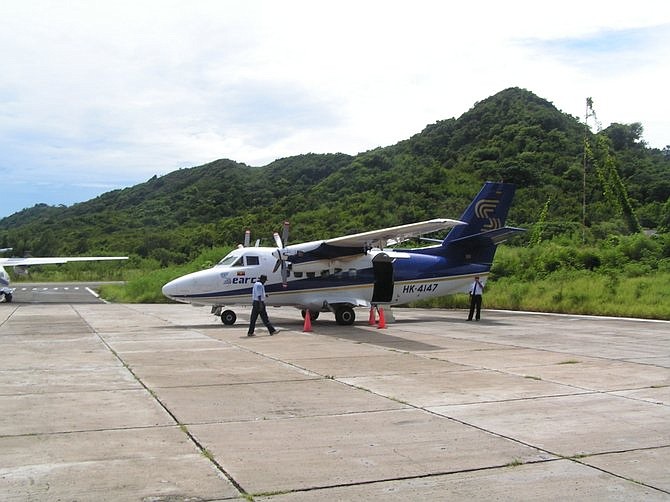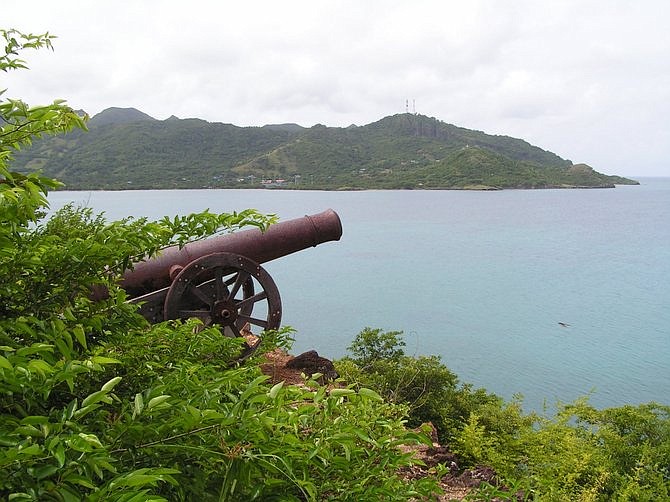 Facebook
Facebook
 X
X
 Instagram
Instagram
 TikTok
TikTok
 Youtube
Youtube

Below us, the island came into view, encircled by a brittle ring of coral reefs made distinguishable by whitewater ripping at the edges. A turquoise iris skirted the white sandy edges of the Caribbean island of Providencia.

Our Russian-built aircraft bobbled in the turbulence kicked up by gnarled volcanic peaks to our left. Behind our seats, two fighting cocks, transported with us on the 20-minute flight from San Andres for the weekend’s entertainment, clucked in panic at sudden jolts.
Without incident we touched down on Providencia, or Old Providence, one of a pair of Colombian Caribbean islands 300 miles from the country’s mainland coast. Located a mere 140 miles from Nicaragua – a fact not lost on Nicaraguan authorities and an international squabble constantly under review at the International Court of Justice – Providencia has played its part in an intriguing history. Its geopolitical importance has unwittingly involved the Miskito Indians of Central America, New England Puritans, English Parliamentarians, pirates and Dutch freebooters, Spanish Imperial claims, and now a sovereignty dispute between Colombia and Nicaragua.
Had everything gone according to original 17th-century English colonial plans and Oliver Cromwell’s “Western Design,” Providencia would have been a hard-working, God-fearing Puritan community prospering in tobacco, cotton and dyes rather than the effortlessly slumbering Caribbean island it is today.
Of the two islands, San Andrés is the larger and more populous and possibly claims the unlikely title of being Colombia’s package holiday destination capital. Topographically underwhelming and blighted by massive chain hotels capitalizing on the Colombian government’s aggressive Colombianization in the form of a tax-free zone, San Andrés is Providencia’s extreme opposite.
The first European to discover the 14 square miles of Providencia could have been Christopher Columbus – but facts to prove it are erroneous at best. So, the first confirmed discovery and settlement of the island took place around the same time as that of Massachusetts Bay by English Puritans, in 1630. These hardy settlers believed that an island off the coast of Nicaragua would be far more enticing to like-minded souls than the cold, foreboding climes of New England.
Making the short ride from the brightly colored wooden airport shack past tropical fertile valleys, I, too, agree wholeheartedly with the ancestors of the Newballs, Bents, Whitakers and Turners. I’d settle here, no questions asked.

Journeying in the open-backed collectivo truck, it hardly comes as a surprise that the Providence Island Company that spearheaded the investments under such notable characters as the ebullient Parliamentarian John Pym and Robert Rich, 2nd Earl of Warwick, believed they could make this venture work. To the trained eye, it’s apparent the island would have been easy to defend, fertile and more importantly – for these businessmen intent on financial gain – at the strategic heart of Spanish-controlled seas. In short, Providencia occupied an unrivalled position from which to harry the trade routes of Spanish galleons laden with wealth from the New World.
The PIC’s efforts in enticing the right godly people lured a group of several hundred New Englanders in addition to colonists from Bermuda and, on the Seaflower, some directly from England. In 1635 it is estimated that more than 500 people had settled Old Providence.
But financially, the venture became a complete disappointment to its backers. The isolation of the island from other English settlements in the region made communication difficult; therefore the illicit trade that sprung up between settlers and Dutch vessels often led to cargo ships returning to England only partly full. The settlers never succeeded in building the kind of united, orderly Puritan community that the New Englanders created. They were beset with labor shortages and so began the large-scale use of slaves. Settlers then plunged into the irresistible temptation of privateering that ultimately resulted in the Spanish conquest of the island in 1641.
What remains of the English today are British surnames and fading legends that herald a time long past.
My efforts to find a local historian to add color drew blanks. Several mainland Colombians on holiday here in Providencia told me to find Virginia Archbold, yet a simple enquiry at the front desk of my guesthouse revealed that Providencia’s most learned and able local historian passed away in 2006. This was a major disappointment. The very name Archbold can only mean a descendant of Francis Archbold, the captain of an 18th-century English slave ship who received a grant from the Spanish government in 1788 to settle the island.
Another name is proffered. I am told, albeit unhelpfully, that I could have talked to old Mr. Huffington, but he too died some months ago. My luck has run out, and the guardians of the island’s history are few in number. Finally, Lucy at the front desk, perhaps exasperated at my continual questioning, puts me in contact with her father Francisco Bent.
“He knows things,” she says.
Lucy’s statement rings true. Francisco Bent’s knowledge and enthusiasm to share it are hardly quelled as his two grandchildren aged 1 and 2 clamber over him and stomp through the two-story house. I want to talk about the notorious pirate Henry Morgan and say so.
A lifelong fisherman and islander, Bent smiles:
“My father was contracted to look for the corsair Henry Morgan’s treasure around Fort Warwick on Santa Catalina in the 1950s, but they found nothing. Or maybe they just weren’t looking in the right place.”
Bent starts to speak fondly of Morgan as if he were a long-time family friend. “We were taught in school that Henry Morgan was a pirate, robber, filibuster. But now we know he wasn’t such a bad guy.”
I don’t want to be sidetracked into revisionist theories surrounding the notorious privateer, but we continue to discuss him since his influence is enormous in Providencia. After all, it was from here that Henry Morgan planned and launched the infamous and astounding sacking of Panama in 1671.
The importance of Providencia was not lost on Morgan. Later, as the Lieutenant Governor of Jamaica, he is said to have listed the tiny island along with Havana, Portobelo, Maracaibo, Cartagena and Veracruz as holding the key to the control of the Caribbean.
With all of the power struggles that Providencia has experienced, I put it to Bent that the islanders must have a bizarre sense of identity. I note that in my readings and investigation there are more people leaving the island than arriving each year, and many islanders now make their home and money working in the Cayman Islands or on neighboring San Andres. Very few head to mainland Colombia. Does he think of himself as Colombian or Caribbean, or would he prefer to be Nicaraguan? Bent thinks for a moment and says:
“Here we have a mixed feeling. The Colombian government does not treat us as a people. We are almost 6,000 people here on the island, 99 percent of us are unemployed. We are promoting more of a separation from Colombia although we do not want to be Nicaraguan. We want to be an autonomous region recognized together with places like Limon in Costa Rica, the Bay Islands in Honduras, Colon in Panama and the Corn Islands in Nicaragua.
“We are not a violent people, and now we are becoming accustomed to armed men everywhere. The Colombian government put their police and army here and we don’t need them. This is the reason why Colombia has problems.”
Strong words from the fisherman from Casa Baja, Providencia.
What's left of this root of English civilization in the Americas is a Caribbean backwater, a Colombian national park that is antithesis to San Andrés. In short, a cliché: long stretches of unspoilt palm-lined white sandy beaches polluted only by lilting reggae beats, complemented by rugged volcanic mountains and mangroves.
Standing on the pristine Playa Manzanillo with my back to Roland’s Bar, it's hard to imagine that in its infancy, Providencia was an attempt to elucidate the motives of Puritan founding fathers. Here, 48 miles away from the duty-free perfumeries of downtown San Andres, the islanders of Providencia spend their days fishing and catering to the idly growing tourism industry.
Still, in keeping with tradition, Providencia remains at the heart of the tangle of geopolitical fallout of colonial ambitions in the Caribbean.


Below us, the island came into view, encircled by a brittle ring of coral reefs made distinguishable by whitewater ripping at the edges. A turquoise iris skirted the white sandy edges of the Caribbean island of Providencia.

Our Russian-built aircraft bobbled in the turbulence kicked up by gnarled volcanic peaks to our left. Behind our seats, two fighting cocks, transported with us on the 20-minute flight from San Andres for the weekend’s entertainment, clucked in panic at sudden jolts.
Without incident we touched down on Providencia, or Old Providence, one of a pair of Colombian Caribbean islands 300 miles from the country’s mainland coast. Located a mere 140 miles from Nicaragua – a fact not lost on Nicaraguan authorities and an international squabble constantly under review at the International Court of Justice – Providencia has played its part in an intriguing history. Its geopolitical importance has unwittingly involved the Miskito Indians of Central America, New England Puritans, English Parliamentarians, pirates and Dutch freebooters, Spanish Imperial claims, and now a sovereignty dispute between Colombia and Nicaragua.
Had everything gone according to original 17th-century English colonial plans and Oliver Cromwell’s “Western Design,” Providencia would have been a hard-working, God-fearing Puritan community prospering in tobacco, cotton and dyes rather than the effortlessly slumbering Caribbean island it is today.
Of the two islands, San Andrés is the larger and more populous and possibly claims the unlikely title of being Colombia’s package holiday destination capital. Topographically underwhelming and blighted by massive chain hotels capitalizing on the Colombian government’s aggressive Colombianization in the form of a tax-free zone, San Andrés is Providencia’s extreme opposite.
The first European to discover the 14 square miles of Providencia could have been Christopher Columbus – but facts to prove it are erroneous at best. So, the first confirmed discovery and settlement of the island took place around the same time as that of Massachusetts Bay by English Puritans, in 1630. These hardy settlers believed that an island off the coast of Nicaragua would be far more enticing to like-minded souls than the cold, foreboding climes of New England.
Making the short ride from the brightly colored wooden airport shack past tropical fertile valleys, I, too, agree wholeheartedly with the ancestors of the Newballs, Bents, Whitakers and Turners. I’d settle here, no questions asked.

Journeying in the open-backed collectivo truck, it hardly comes as a surprise that the Providence Island Company that spearheaded the investments under such notable characters as the ebullient Parliamentarian John Pym and Robert Rich, 2nd Earl of Warwick, believed they could make this venture work. To the trained eye, it’s apparent the island would have been easy to defend, fertile and more importantly – for these businessmen intent on financial gain – at the strategic heart of Spanish-controlled seas. In short, Providencia occupied an unrivalled position from which to harry the trade routes of Spanish galleons laden with wealth from the New World.
The PIC’s efforts in enticing the right godly people lured a group of several hundred New Englanders in addition to colonists from Bermuda and, on the Seaflower, some directly from England. In 1635 it is estimated that more than 500 people had settled Old Providence.
But financially, the venture became a complete disappointment to its backers. The isolation of the island from other English settlements in the region made communication difficult; therefore the illicit trade that sprung up between settlers and Dutch vessels often led to cargo ships returning to England only partly full. The settlers never succeeded in building the kind of united, orderly Puritan community that the New Englanders created. They were beset with labor shortages and so began the large-scale use of slaves. Settlers then plunged into the irresistible temptation of privateering that ultimately resulted in the Spanish conquest of the island in 1641.
What remains of the English today are British surnames and fading legends that herald a time long past.
My efforts to find a local historian to add color drew blanks. Several mainland Colombians on holiday here in Providencia told me to find Virginia Archbold, yet a simple enquiry at the front desk of my guesthouse revealed that Providencia’s most learned and able local historian passed away in 2006. This was a major disappointment. The very name Archbold can only mean a descendant of Francis Archbold, the captain of an 18th-century English slave ship who received a grant from the Spanish government in 1788 to settle the island.
Another name is proffered. I am told, albeit unhelpfully, that I could have talked to old Mr. Huffington, but he too died some months ago. My luck has run out, and the guardians of the island’s history are few in number. Finally, Lucy at the front desk, perhaps exasperated at my continual questioning, puts me in contact with her father Francisco Bent.
“He knows things,” she says.
Lucy’s statement rings true. Francisco Bent’s knowledge and enthusiasm to share it are hardly quelled as his two grandchildren aged 1 and 2 clamber over him and stomp through the two-story house. I want to talk about the notorious pirate Henry Morgan and say so.
A lifelong fisherman and islander, Bent smiles:
“My father was contracted to look for the corsair Henry Morgan’s treasure around Fort Warwick on Santa Catalina in the 1950s, but they found nothing. Or maybe they just weren’t looking in the right place.”
Bent starts to speak fondly of Morgan as if he were a long-time family friend. “We were taught in school that Henry Morgan was a pirate, robber, filibuster. But now we know he wasn’t such a bad guy.”
I don’t want to be sidetracked into revisionist theories surrounding the notorious privateer, but we continue to discuss him since his influence is enormous in Providencia. After all, it was from here that Henry Morgan planned and launched the infamous and astounding sacking of Panama in 1671.
The importance of Providencia was not lost on Morgan. Later, as the Lieutenant Governor of Jamaica, he is said to have listed the tiny island along with Havana, Portobelo, Maracaibo, Cartagena and Veracruz as holding the key to the control of the Caribbean.
With all of the power struggles that Providencia has experienced, I put it to Bent that the islanders must have a bizarre sense of identity. I note that in my readings and investigation there are more people leaving the island than arriving each year, and many islanders now make their home and money working in the Cayman Islands or on neighboring San Andres. Very few head to mainland Colombia. Does he think of himself as Colombian or Caribbean, or would he prefer to be Nicaraguan? Bent thinks for a moment and says:
“Here we have a mixed feeling. The Colombian government does not treat us as a people. We are almost 6,000 people here on the island, 99 percent of us are unemployed. We are promoting more of a separation from Colombia although we do not want to be Nicaraguan. We want to be an autonomous region recognized together with places like Limon in Costa Rica, the Bay Islands in Honduras, Colon in Panama and the Corn Islands in Nicaragua.
“We are not a violent people, and now we are becoming accustomed to armed men everywhere. The Colombian government put their police and army here and we don’t need them. This is the reason why Colombia has problems.”
Strong words from the fisherman from Casa Baja, Providencia.
What's left of this root of English civilization in the Americas is a Caribbean backwater, a Colombian national park that is antithesis to San Andrés. In short, a cliché: long stretches of unspoilt palm-lined white sandy beaches polluted only by lilting reggae beats, complemented by rugged volcanic mountains and mangroves.
Standing on the pristine Playa Manzanillo with my back to Roland’s Bar, it's hard to imagine that in its infancy, Providencia was an attempt to elucidate the motives of Puritan founding fathers. Here, 48 miles away from the duty-free perfumeries of downtown San Andres, the islanders of Providencia spend their days fishing and catering to the idly growing tourism industry.
Still, in keeping with tradition, Providencia remains at the heart of the tangle of geopolitical fallout of colonial ambitions in the Caribbean.
Comments